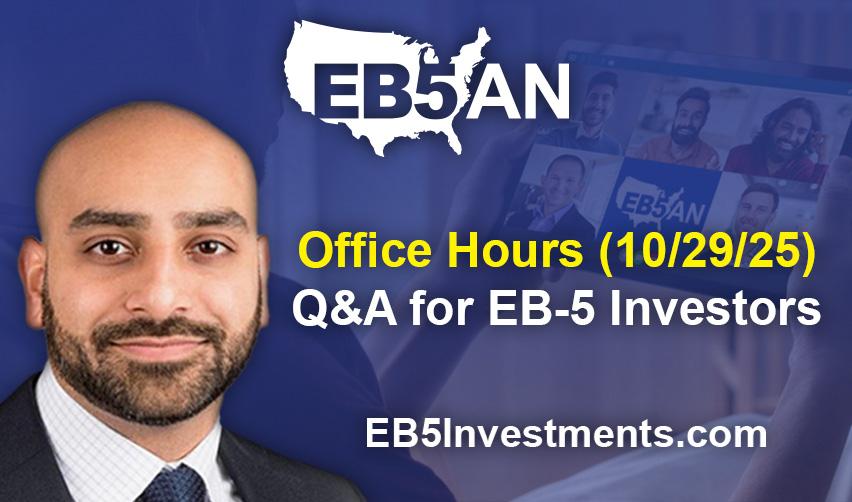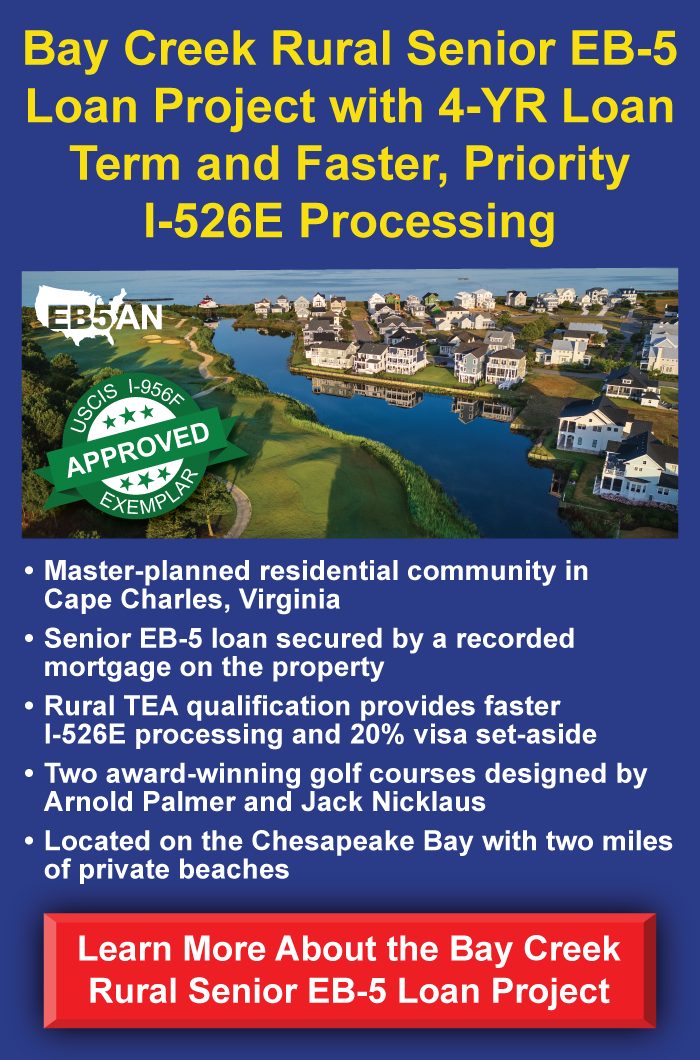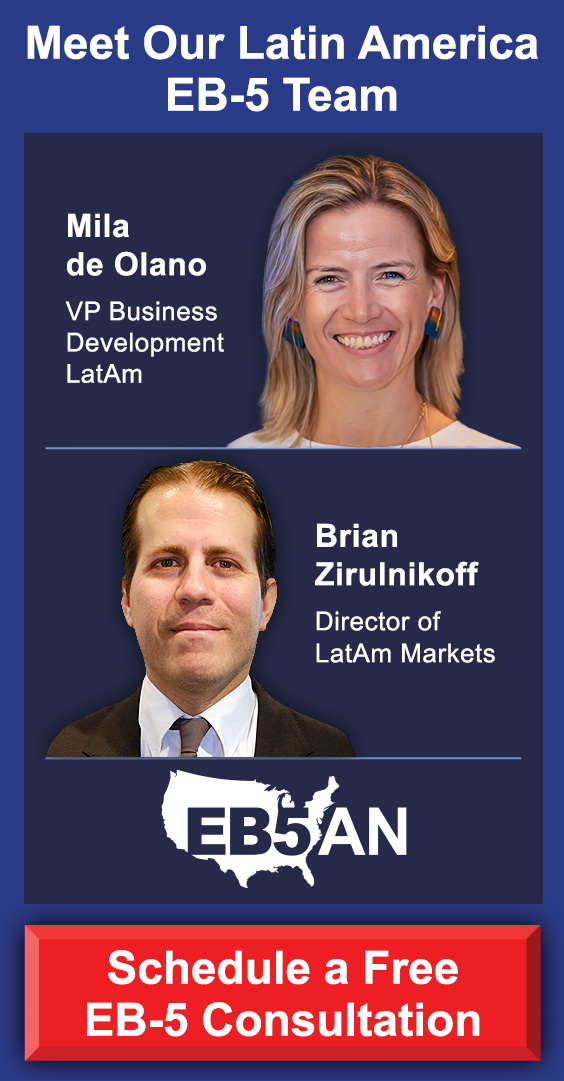EB5AN’s “Office Hours” Q&A sessions continue to be a reliable source of insight for EB-5 investors seeking direct, experience-based answers. These sessions provide an open forum to explore key aspects of the EB-5 process, from visa timelines to investment structure and source-of-funds requirements.
EB-5 Basics and Investment Requirements
Source of Funds and Loan Options
Rural vs. Urban Project Timelines
Concurrent Filing and Retrogression Strategy
Repayment Terms and Project Safety
Country Caps and the RIA 2027 Deadline
Choosing Safer EB-5 Projects
Keep Learning With EB5AN’s “Office Hours” Q&A
Watch October 29 Session Highlights:
Hosted by EB5AN Senior Vice President Ahmed Khan, the October 29 discussion focused on investor questions about funding, repayment, and Green Card timelines. Ahmed drew from his background as both an immigration attorney and a regional center executive to help investors understand the EB-5 process more clearly and make informed filing decisions.
EB-5 Basics and Investment Requirements
Ahmed began with an overview of the EB-5 program, emphasizing that it is an employment-based Green Card category requiring a minimum investment of $800,000 in either a rural or high-unemployment (urban) Targeted Employment Area.
He noted that rural projects receive priority processing, with most investors approved within six to nine months, while urban high-unemployment filings typically take longer for adjudication. After petition approval, investors can expect another six to eight months for adjustment of status or consular processing.
Source of Funds and Loan Options
Ahmed fielded multiple questions about how investors can lawfully source their EB-5 investment funds. He explained that the capital can come from personal savings, family gifts, or loans, but investors must always prove the lawful origin of funds.
One of the most common sources is a loan against owned property, a method widely used by EB-5 investors. However, he noted that investors in India face additional restrictions due to RBI rules on expatriating funds. “From an EB-5 perspective, loans against property are fully allowed,” he said. “The challenge comes from Indian banking regulations, not USCIS.”
Rural vs. Urban Project Timelines
While priority processing continues to benefit rural filings, Ahmed explained that investors in urban high-unemployment projects have seen approvals in under a year when using strategies like mandamus litigation—a limited legal option to expedite long-pending cases.
Still, he emphasized managing expectations: “We’ve filed hundreds of cases. Rural petitions are consistently faster, but for high-unemployment projects, you should plan for 18 to 24 months on average.”
Concurrent Filing and Retrogression Strategy
Ahmed discussed the advantages of filing EB-5 petitions while the Visa Bulletin remains current, particularly for investors already in the U.S. under other visa categories. Filing concurrently allows investors to apply for adjustment of status and receive work and travel authorization while waiting for Green Card approval.
“Even if the category retrogresses the next month, you still get your EAD and advance parole,” he explained. “It doesn’t prevent long-term delays, but it gives you immediate flexibility—especially valuable for those facing job uncertainty.”
He also outlined the tight filing windows that can occur before retrogression. For example, if the Visa Bulletin retrogresses in December, investors could have just two weeks in November to file while still current.
Repayment Terms and Project Safety
Investors frequently asked how long EB-5 capital remains deployed. Ahmed clarified that repayment terms vary by project, depending on the developer’s size, financial structure, and track record.
He noted that larger, established developers often offer longer but lower-risk loan terms, while smaller developers may have shorter durations but higher risk. “It’s always a tradeoff,” he said. “You might wait a bit longer for repayment, but your capital is in safer hands.”
Ahmed also confirmed that repayment schedules are not tied to whether a project is rural or urban—they are determined entirely by project structure and loan agreements.
Country Caps and the RIA 2027 Deadline
Ahmed reviewed the annual EB-5 visa limits and per-country cap of roughly 7%, explaining how set-aside visas under the Reform and Integrity Act (RIA) help offset delays for investors from high-demand countries like India and China.
“There are roughly 18,000 EB-5 visas available this year, far more than the standard 10,000,” he said. “With 2,000 visas reserved for rural and 1,000 for high-unemployment projects, Indian investors still have strong chances for faster approvals.”
He also addressed concerns about the RIA’s 2027 sunset date, clarifying that investors who file before September 30, 2026, will be grandfathered in, even if the regional center program lapses later.
Choosing Safer EB-5 Projects
In closing, Ahmed discussed what makes an EB-5 project safer from both a financial and immigration standpoint. He highlighted residential master-planned communities as lower-risk asset classes due to their phased construction, steady cash flow from home sales, and proven market demand.
“Unlike hotels or commercial buildings that depend entirely on future performance, residential projects generate capital as they go,” he explained. “That flexibility helps protect investors in changing markets.”
He also urged investors to look beyond buzzwords: “Being a senior lender only matters if your collateral is worth more than your loan. Always check the loan-to-value ratio and ensure your regional center is aligned with your interests.”
Watch the Full October 29 Session:
Keep Learning With EB5AN’s “Office Hours” Q&A
EB5AN’s “Office Hours” sessions are designed to promote transparency and direct investor education. Participants gain practical guidance from industry professionals and the opportunity to ask live questions on filing, project selection, and immigration strategy.
If you missed the October 29 session, you can watch the recap videos above or register for the next live event. Investors unable to attend are also encouraged to book a one-on-one call with the EB5AN team to discuss current projects and filing strategies.









